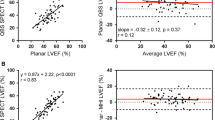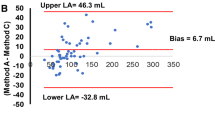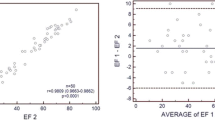Abstract
The aim of this study was to assess the feasibility of non-invasive determination of cardiac function from test-bolus data in multislice spiral computed tomography (MSCT). In 25 patients enhancement data gathered from a standardized test-bolus injection were analyzed. The test-bolus examination was performed prior to a retrospectively ECG-gated MSCT of the heart. A time–attenuation curve was obtained in the ascending aorta at the level of the pulmonary arteries. A gamma variate fit was applied to the curve in order to exclude recirculation and get pure first-pass data. Using the known amount of iodine injected, cardiac output (CO), and stroke volume (SV) were determined from integration of the fitted contrast enhancement curve using a reformation of the Stewart-Hamilton equation. Results were compared with CO and SV calculated from the geometric analysis of the retrospectively gated MSCT data using the ARGUS Software (Siemens, Forchheim, Germany). The CO and SV determined from test-bolus analysis and from geometric analysis correlated well with Pearson's correlation coefficients of 0.87 and 0.88, respectively. The standard deviation of the difference between both methods was 0.51 l/min for CO (8.6%) and 11.0 ml for SV (12.3%). Non-invasive quantification of CO seems to be feasible from a standard test-bolus injection. It provides valuable information on cardiac function without additional radiation or application of contrast material.






Similar content being viewed by others
References
Klingenbeck-Regn K, Schaller S, Flohr T, Ohnesorge B, Kopp AF, Baum U (1999) Subsecond multi-slice computed tomography: basics and applications. Eur J Radiol 31:110–124
Ohnesorge B, Flohr T, Becker C, Kopp AF, Schoepf UJ, Baum U, Knez A, Klingenbeck-Regn K, Reiser MF (2000) Cardiac imaging by means of electrocardiographically multi-section spiral CT: initial experience. Radiology 217:564–571
Rodenwaldt J (2003) Multi-slice computed tomography of the coronary arteries. Eur Radiol 13:748–757
Flohr T, Prokop M, Becker C, Schoepf UJ, Kopp AF, White RD, Schaller S, Ohnesorge B (2002) A retrospectively ECG-gated multi-slice spiral CT scan and reconstruction technique with suppression of heart pulsation artifacts for cardio-thoracic imaging with extended volume coverage. Eur Radiol 12:1497–1503
Juergens KU, Grude M, Fallenberg EM, Opitz C, Wichter T, Heindel W, Fischbach R (2002) Using ECG-gated multi-detector CT to evaluate global left ventricular myocardial function in patients with coronary artery disease. Am J Roentgenol 179:1545–1550
Mahnken AH, Spuntrup E, Wildberger JE, Heuschmid M, Niethammer M, Sinha AM, Flohr T, Bücker A, Gunther RW (2003) Quantification of cardiac function with multi-slice spiral CT using retrospective EKG-gating: comparison with MRI. Fortschr Röntgenstr 175:83–88
Halliburton SS, Petersilka M, Schvartzman PR, Obuchowski N, White RD (2003) Evaluation of left ventricular dysfunction using multiphasic reconstructions of coronary multi-slice computed tomography data in patients with chronic ischemic heart disease: validation against cine magnetic resonance imaging. Int J Cardiovasc Imaging 19:73–83
Fleischmann D, Rubin GD, Bankier AA, Hittmair K (2000) Improved uniformity of aortic enhancement with customized contrast-medium injection protocols at CT angiography. Radiology 214:363–371
Kaatee R, van Leeuwen MS, de Lange EE, Wilting JE, Beek FJ, Beutler JJ, Mali WP (1998) Spiral CT angiography of the renal arteries: Should a scan delay based on a test-bolus injection or a fixed-scan delay be used to obtain maximum enhancement of the vessels? J Comput Assist Tomogr 22:541–547
Van Hoe L, Marchal G, Baert AL, Gryspeerdt S, Mertens L (1995) Determination of scan delay time in spiral CT angiography: utility of a test-bolus injection. J Comput Assist Tomogr 19:216–220
Herfkens RJ, Axel L, Lipton MJ, Napel S, Berninger W, Redington R (1982) Measurement of cardiac output by computed transmission tomography. Invest Radiol 17:550–553
Garrett JS, Lanzer P, Jaschke W, Botvinick E, Sievers R, Higgins CB, Lipton MJ (1985) Measurement of cardiac output by cine computed tomography. Am J Cardiol 56:657–661
Wolfkiel CJ, Ferguson JL, Chomka EV, Law WR, Brundage BH (1986) Determination of cardiac output by ultrafast computed tomography. Am J Physiol Imaging 1:117–123
Stewart GN (1897) Research on the circulation time and the influence which affects it. IV. The output of the heart. J Physiol 2:159–183
Hamilton WT, Moore JW, Kinsman JM, Spurling RG (1932) Studies on the circulation: further analysis of the injection method and of changes in hemodynamics under physiological and pathological conditions. Am J Physiol 99:534–551
Ludman PF, Coats AJ, Poole-Wilson PA, Rees RS (1993) Measurement accuracy of cardiac output in humans: indicator dilution technique vs geometric analysis by ultrafast computed tomography. J Am Coll Cardiol 21:1482–1489
Kalender WA, Schmidt B, Zankl M, Schmidt M (1999) A PC program for estimating organ dose and effective dose values in computed tomography. Eur Radiol 9:552–562
Thompson BH, Stanford W (1994) Evaluation of cardiac function with ultrafast computed tomography. Radiol Clin North Am 32:537–551
Flohr T, Ohnesorge B (2001) Heart rate adaptive optimization of spatial and temporal resolution for electrocardiogram-gated multi-slice spiral CT of the heart. J Comput Assist Tomogr 25:907–923
American Heart Association, American College of Cardiology, Society of Nuclear Medicine (1992) Standardization of cardiac tomographic imaging. From the Committee on Advanced Cardiac Imaging and Technology, Council on Clinical Cardiology, American Heart Association; Cardiovascular Imaging Committee, American College of Cardiology; and Board of Directors, Cardiovascular Council, Society of Nuclear Medicine. Circulation 86:338–339
Schalla S, Nagel E, Lehmkuhl H, Klein C, Bornstedt A, Schnackenburg B, Schneider U, Fleck E (2001) Comparison of magnetic resonance real-time imaging of left ventricular function with conventional magnetic resonance imaging and echocardiography. Am J Cardiol 87:95–99
Moon JC, Lorenz CH, Francis JM, Smith GC, Pennell DJ (2002) Breath-hold FLASH and FISP cardiovascular MR imaging: left ventricular volume differences and reproducibility. Radiology 223:789–797
Thompson HK, Starmer CF, Whalen RE, McIntosh HD (1963) Indicator transit time considered as gamma variate. Circ Res 14:502–515
Cademartiri F, van der Lugt A, Luccichenti G, Pavone P, Krestin GP (2002) Parameters affecting bolus geometry in CTA: a review. J Comput Assist Tomogr 26:598–607
Bland JM, Altman DG (1986) Statistical methods for assessing agreement between two methods of clinical measurement. Lancet 1:307–310
International Commission on Radiation Protection (1991) 1990 Recommendations of the International Commission on Radiation Protection. ICRP publication no. 60. Pergamon, Oxford
Kaminaga T, Naito H, Takamiya M, Nishimura T (1994) Quantitative evaluation of mitral regurgitation with ultrafast CT. J Comput Assist Tomogr 18:239–242
Botero M, Lobato EB (2001) Advances in noninvasive cardiac output monitoring: an update. J Cardiothorac Vasc Anesth 15:631–640
Baik HK, Budoff MJ, Lane KL, Bakhsheshi H, Brundage BH (2000) Accurate measures of left ventricular ejection fraction using electron-beam tomography: a comparison with radionuclide angiography, and cine angiography. Int J Card Imaging 16:391–398
Juergens KU, Fischbach R, Grude M, Wichter T, Fallenberg EM, Opitz C, Heindel WL (2002) Evaluation of left ventricular myocardial function by retrospectively ECG-gated multi-slice spiral CT in comparison to cine magnetic resonance imaging. Eur Radiol 12 (Suppl 1):S191
Platt JF, Reige KA, Ellis JH (1999) Aortic enhancement during abdominal CT angiography: correlations with test injections, flow rates, and patient demographics. Am J Roentgenol 172:53–56
Hittmair K, Fleischmann D (2001) Accuracy of predicting and controlling time-dependent aortic enhancement from a test-bolus injection. J Comput Assist Tomogr 25:287–294
Mancini GB, Bloomquist JN, Bhargava V, Stein JB, Lew W, Slutsky RA, Shabetai R, Higgins CB (1983) Hemodynamic and electrocardiographic effects in man of a new nonionic contrast agent (Iohexol): advantages over standard ionic agents. Am J Cardiol 51:1218–1222
Bettmann MA, Higgins CB (1985) Comparison of an ionic with a nonionic contrast agent for cardiac angiography: results of a multicenter trial. Invest Radiol 20:S70–S74
Kopp AF, Küttner A, Heuschmid M, Schröder S, Ohnesorge B, Claussen CD (2002) Multidetector-row CT cardiac imaging with 4 and 16 slices for coronary CTA and imaging of atherosclerotic plaques. Eur Radiol 12 (Suppl 2):S17–S24
Peshock RM, Willett DL, Sayad DE, Hundley WG, Chwialkowski MC, Clarke GD, Parkey RW (1996) Quantitative MR imaging of the heart. Magn Reson Imaging Clin N Am 4:287–305
Boyd DP, Lipton MJ (1983) Cardiac computed tomography. Proc IEEE Nucl Sci 71:298–307
Author information
Authors and Affiliations
Corresponding author
Rights and permissions
About this article
Cite this article
Mahnken, A.H., Klotz, E., Hennemuth, A. et al. Measurement of cardiac output from a test-bolus injection in multislice computed tomography. Eur Radiol 13, 2498–2504 (2003). https://doi.org/10.1007/s00330-003-2054-x
Received:
Revised:
Accepted:
Published:
Issue Date:
DOI: https://doi.org/10.1007/s00330-003-2054-x




